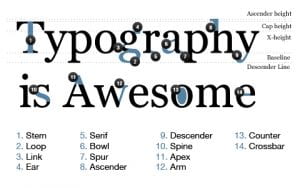 In class the anatomy of type was discussed and it was really interesting as I had never really thought about the different elements of type before.
In class the anatomy of type was discussed and it was really interesting as I had never really thought about the different elements of type before.
Typeface Anatomy is describes the graphic elements that make up letters in a typeface.
Understanding the anatomy and what goes into type is important as it let’s the designer know what right and wrong with their type so that way they can use it effectively and appropriately.
Type Element Explained:-
- Baseline – Majority of the characters sit on this imaginary horizontal line.
- Cap height – The capline or cap height is another imaginary line wherein the heights of all the capital letters are marked in a typeface. However one has to keep in mind that the cap height is below the maximum height of the typeface.
- Crossbar – The crossbar is a stroke that connects 2 lines in capital letterforms of “A” and “H”. Again a cross stroke implies a horizontal stroke that does not connect two lines, for example, the lower case of “f” or “t”.
- Serif – It is the name assigned to the finishing strokes at the tops and bottoms of some typefaces. There is a lot to discuss serifs when we would learn about typeface distinctions.
- Mean line – The mean line better is known as midline is another imaginary horizontal line that marks the top edges of the lower case letters. You go wrong if you go by the literal definition of the term “mean line” because it actually doesn’t imply the central line between the baseline and the cap height.
- Bowl – It is nothing but the rounded curve that covers the negative space in a letter form. Consider, for example, it can be easily viewed in the following letters “I”, “e”, “D”, “o” and “g”.
- Descender – Descender happens to be the bottom part of the lowercase letter (like “g”, “j”, “p”, “q”, “y” etc) that usually goes below the baseline of a typeface. Some other features that particularly extend below this baseline comprise of the old style numerals typefaces. These specific numerals were basically thought to mix appropriately with the lowercase roman numbers. If used within the body of the text they really look good and beautiful.
- Counter – Counter refers to the negative space within a letter, particularly if you consider letters like “A”, “o” and “P” etc where the counter is fully enclosed. In letters like “G”, “u” and “c” the non enclosed negative space is reflected and they are also called counters.
- Stem – The main vertical or diagonal stroke depicted in a letterform is known as Stem. They consists of the vertical parts of the letters like “I” and “H” and also simultaneously all the strokes in the letter “W”.
- Tittle – The title is defined as the dot above the lowercase “j” and “i”.
- Terminal – The terminal is the culmination point of the stroke or stem that has no serif.
- Ascender -It is an extension that goes above the meanline and is generally found in some lowercase letters. These letters are, “b”, “d”, “f”, “h”, “k”, “l” and “t”.
- Leg – Legs are the lower angled strokes which you can see in the letters “K”, “R” and “Q”. They are also known as tails.
- Ligature – This addition of two characters to create another character is called ligature. They are commonly seen in serif faces .It is present to give space between certain characters and give the characters an aesthetic imprint.
- X-height – The space that exists in the vertical direction for the lowercase “x” in any typeface is known as X-Height. It is the distance the baseline and mean line of the body of characters in lowercase form. The X-Height is very important in the context of font shapes as the fonts with greater X-heights are easier to read
There are many different elements within a typeface, the list above are some of the main ones.
In order to further learn about the anatomy of type and the elements that go into it I was given a task in which I had to write out my name and define all the different elements within it. I chose to use the typeface Constatina as it is one of my favourite typefaces.
Doing this task helped me identify and realise various different elements within the anatomy of a typeface. I feel as if knowing the anatomy would come in valuable and would help my use of type to be better in the future
